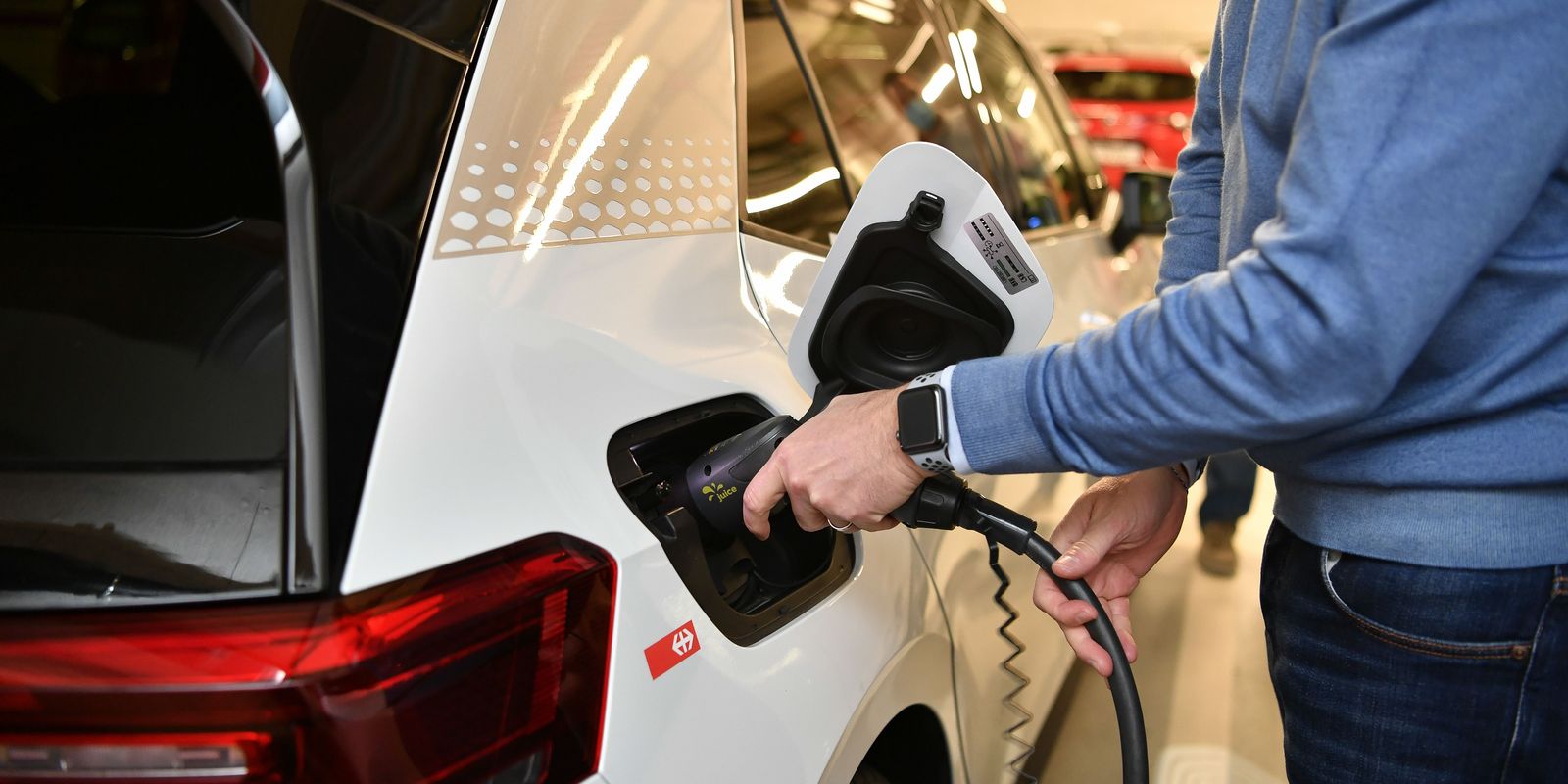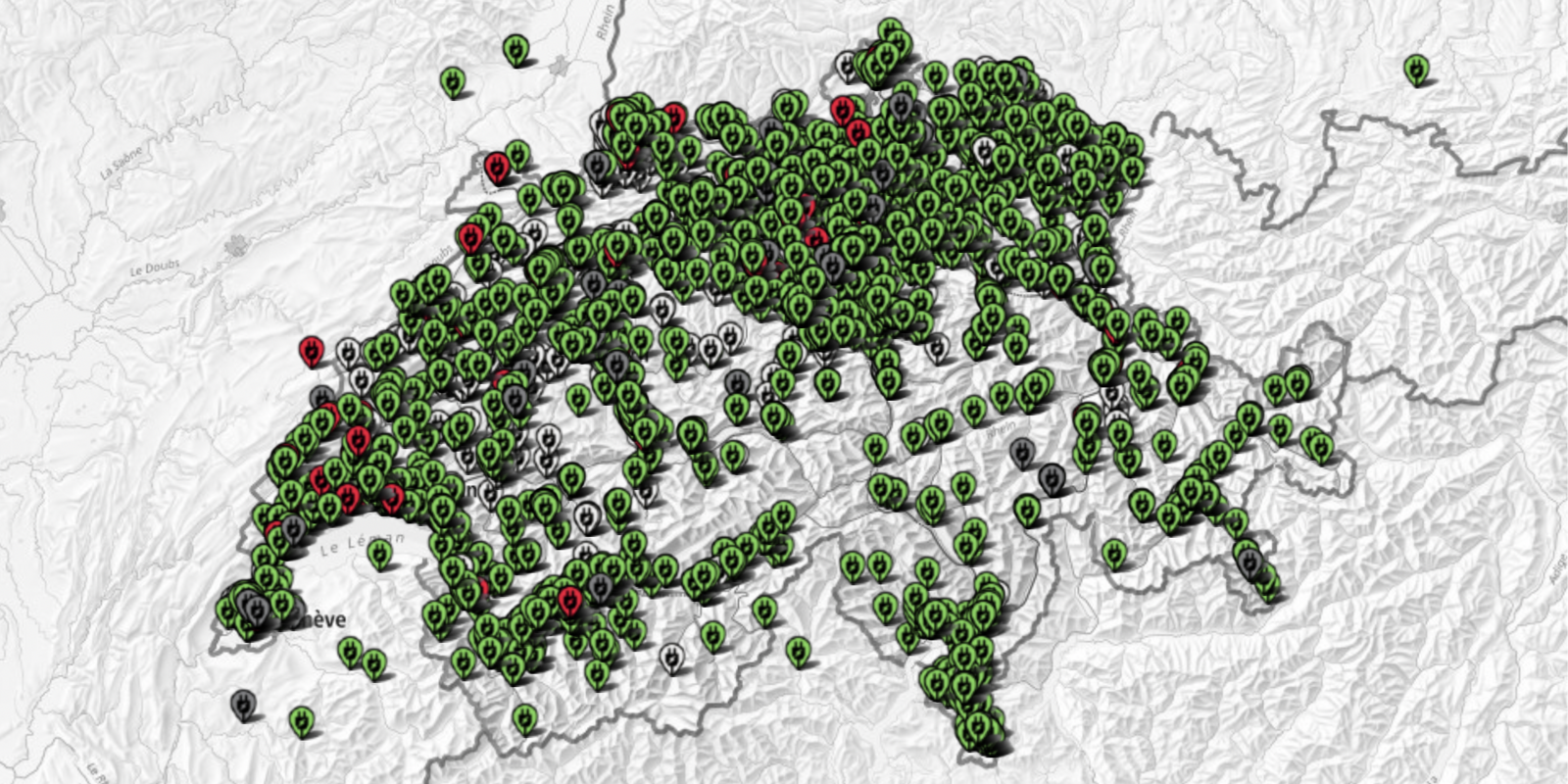This much is for sure: The fear of running out of range in an electric car is becoming less and less justified. Vehicle range is increasing and the Swiss public network offers more than 6'300 charging points (as of October 2021). Electric drivers will still need to learn a few new habits though. For example, checking whether a particular public charging column is free, or quickly planning a longer journey using appropriate tools.
important terms
Charging point
Facility for charging 1 electric car
Charging column
Consists of 1 or more charging points
Charging station
Location with 1 or more charging columns
AC / DC
AC = charging with alternating current = slow
DC = charging with direct current = fast
Where do you get an overview of electric charging stations?
As well as the apps from big providers like eCharge or Gofast, there is also www.ich-tanke-strom.ch which offers a helpful interactive map, operated jointly by EnergieSchweiz, BFE and Swisstopo.
Clicking on a location provides precise information about the charging station. Icons indicate whether at least one space is free (green), all spaces are occupied (red), spaces are reserved (orange), the status is unknown (white) or the station is out of service (dark grey). It's also easy to connect stations and calculate distances. Today, 24 operators of electric charging stations are included, offering around 3’100 stations with a total of more than 6'300 charging points. There is no information on prices. For this, you are referred to the individual provider. However, you can see which payment methods are accepted (credit card, app, QR code).
How are things on the motorways?
For electric cars to be usable on long journeys as well as shorter ones, there has to be enough fast charging infrastructure along the 1'850 kilometres of national motorway network. This goal was included in the "Electromobility Roadmap", signed at the end of 2018 by invitation from the Federal Department of the Environment, Transport, Energy and Communications (DETEC). As of today, there are 59 service stations and 100 rest stops in operation along the motorways which can be used for charging.
In the coming years, all 100 motorway rest stops will be equipped with fast-charging stations
The first of 100 fast charging stations was opened in June 2020 at the rest stop Inseli bei Sempach. Based on current plans, by the end of 2021, around half of rest stops should be equipped with fast charging. The stations have all of the common plug types, allowing charging at up to 150 kW, whereby multiple vehicles can charge at full power simultaneously.
When the expansion is complete, the motorway situation will look extremely favourable for you as an electric car driver. On average, you'll be able to reach a service station every 60 km and a rest stop every 40 km.
A few important suppliers of fast-charging stations
| Charging Locations | Fast charging points (DC) |
eCarUp | 703 | 42 |
Fastned | 2 | 12 |
Gofast | 64 | 176 |
MOVE | 482 | 270 |
Swisscharge | 492 | 395 |
TCS eCharge | 492 | 395 |
eCarUp is a charging station provider for companies and private individuals. Fastned is a fast-growing network that is currently primarily in the Netherlands, Belgium and Germany; in Switzerland, there are DC-stations in Lenzburg and Suhr. The other providers mentioned are the current market leaders.
For all the listed providers, the customer can pay via RFID card as well as via app/credit card.
« Expert tip: Only charge your battery to 80% »
How much "juice" does your electric car actually need? And what does it cost?
It's important to know the consumption of your own electric car so you can give it enough charge to meet your needs. Experts recommend only charging the battery to 80% rather than 100% because it takes significantly longer to charge the final 20%. This also makes batteries last longer.
The website www.verbrauchskatalog.ch, provides an outstanding level of information on electric vehicle energy consumption. It lists 3'000 models and variants in great detail, down to the petrol equivalent and tax benefits. This tool is also ideal for comparing the energy efficiency of the different vehicle types. Here, for example, is the VW ID.3, which is part of the Mobility fleet.
Mobility aims for 300 stations by 2023
Together with its partners, Mobility is building hundreds of e-charging stations across Switzerland. By the end of 2023 there should be at least 300. We are also making use of SBB investment in charging infrastructure: In two years, 150 new electric cars will be available to you at around 50 Swiss railway stations.
We are setting up fast charging stations together with our partner Swisscharge. The Swisscharge card is already in all of our electric vehicles today. As usual, the charging fees are included in the Mobility tariff.
If you book a Mobility electric vehicle, there will be enough charge at the start of your hire. As our customer, you won't need to worry about that. The way we make this work is with sophisticated time management and "dedicated charging periods" for each individual vehicle.
There is a huge number of figures on this topic and most of them change rapidly. So we'll just offer a few of them here to enlighten you.
How much range can you get by charging for 1 hour? The charging speed of electric cars is expressed in range gained per hour, so in kilometres of range per hour of charging. In everyday life that looks like this:
Charging stations in parking garages and at public car parks (at 11–22 kW)
50 to 100 additional km per hour of charging
Larger public charging stations on motorways (50 kW, DC)
100 to 200 additional km per hour of charging
Fast charging stations on motorways (150 kW, DC)
200 to 750 additional km per hour of charging
What can you do with a kilowatt-hour?

Vacuum for 1 hour

Run a 100-watt bulb for 10 hours

Wash 1 load of laundry

Watch TV for 5 hours

Blow dry your hair for 30 minutes
This varies depending on device performance. Source: TCS eMotion special edition 1/2021



Your comment